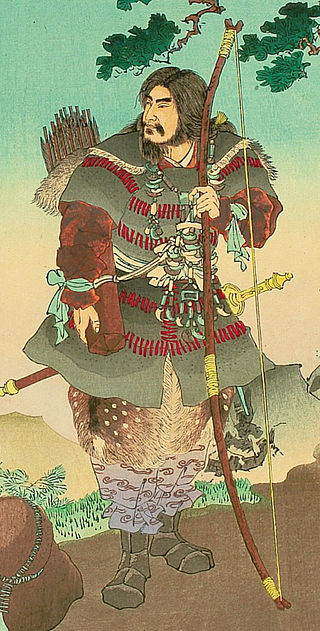
Emperor Jimmu was the legendary first emperor of Japan according to the Nihon Shoki and Kojiki. His ascension is traditionally dated as 660 BC. In Japanese mythology, he was a descendant of the sun goddess Amaterasu, through her grandson Ninigi, as well as a descendant of the storm god Susanoo. He launched a military expedition from Hyūga near the Seto Inland Sea, captured Yamato, and established this as his center of power. In modern Japan, Emperor Jimmu's legendary accession is marked as National Foundation Day on February 11. Amidst nationalist sentiments during the 1930s and 1940s in Imperial Japan, it was dangerous to question the existence of Emperor Jimmu.
Kami are the deities, divinities, spirits, phenomena or "holy powers" that are venerated in the Shinto religion. They can be elements of the landscape, forces of nature, or beings and the qualities that these beings express; they can also be the spirits of venerated dead people. Many kami are considered the ancient ancestors of entire clans. Traditionally, great leaders like the Emperor could be or became kami.
Susanoo is a kami in Japanese mythology. The younger brother of Amaterasu, goddess of the sun and mythical ancestress of the Japanese imperial line, he is a multifaceted deity with contradictory characteristics, being portrayed in various stories either as a wild, impetuous god associated with the sea and storms, as a heroic figure who killed a monstrous serpent, or as a local deity linked with the harvest and agriculture. Syncretic beliefs that arose after the introduction of Buddhism to Japan also saw Susanoo becoming conflated with deities of pestilence and disease.
The Kojiki, also sometimes read as Furukotofumi or Furukotobumi, is an early Japanese chronicle of myths, legends, hymns, genealogies, oral traditions, and semi-historical accounts down to 641 concerning the origin of the Japanese archipelago, the kami (神), and the Japanese imperial line. It is claimed in its preface to have been composed by Ō no Yasumaro at the request of Empress Genmei in the early 8th century (711–712), and thus is usually considered to be the oldest extant literary work in Japan.

Kunado-no-Kami, alternately Kunato-no-Kami, Funado-no-Kami, Funato-no-Kami, or Chimata-no-Kami, are Japanese local gods connected chiefly with protection against disaster and malicious spirits.
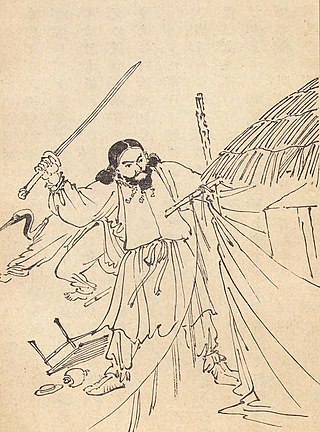
Ajisukitakahikone is a kami in Japanese mythology.
Many Japanese words of Portuguese origin entered the Japanese language when Portuguese Jesuit priests introduced Christian ideas, Western science, technology and new products to the Japanese during the Muromachi period.
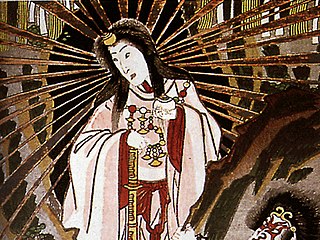
In Japanese mythology, Takamagahara, is the abode of the heavenly gods (amatsukami). Often depicted as located up in the sky, it is believed to be connected to the Earth by the bridge Ame-no-ukihashi.
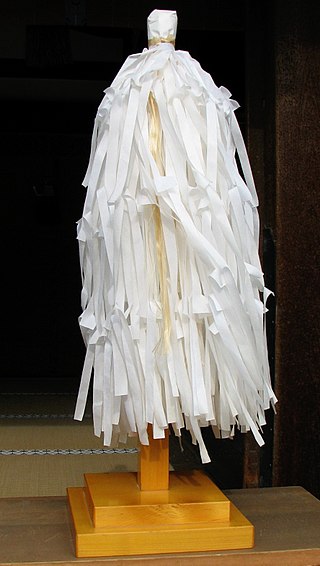
An ōnusa or simply nusa or Taima is a wooden wand traditionally used in Shinto purification rituals.

Toyouke-Ōmikami is the goddess of agriculture and industry in the Shinto religion. Originally enshrined in the Tanba region of Japan, she was called to reside at Gekū, Ise Shrine, about 1,500 years ago at the age of Emperor Yūryaku to offer sacred food to Amaterasu Ōmikami, the Sun Goddess.
The following is a family tree of the emperors of Japan, from the legendary Emperor Jimmu to the present monarch, Naruhito.
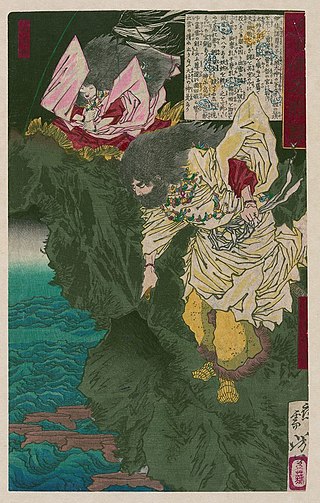
Kushinadahime (クシナダヒメ), also known as Kushiinadahime (クシイナダヒメ) or Inadahime among other names, is a goddess (kami) in Japanese mythology. She is one of the wives of the god Susanoo, who rescued her from the monster Yamata no Orochi.

Takemikazuchi (建御雷/武甕槌) is a deity in Japanese mythology, considered a god of thunder and a sword god. He also competed in what is considered the first sumo wrestling match recorded in history.

Takeminakata (タケミナカタ), also known as Minakatatomi or Takeminakatatomi, is a kami in Japanese mythology. Also known as Suwa Myōjin (諏訪明神) or Suwa Daimyōjin (諏訪大明神) after Suwa Grand Shrine in Nagano Prefecture in which he is enshrined alongside his consort Yasakatome, Takeminakata is historically worshiped as a god of wind, water and agriculture, as well as a patron of hunting and warfare, in which capacity he enjoyed a particularly fervent cult from various samurai clans during the medieval period such as the Hōjō or the Takeda. Takeminakata was also held to be the mythical ancestor of certain families who once served at the shrine as priests, foremost among them being the Suwa clan, the high priests of the Upper Shrine of Suwa who were also revered as living vessels of the god.

Ōmononushi is a kami in Japanese mythology associated with Mount Miwa in Sakurai, Nara Prefecture. He is closely linked in the imperial myth cycle recorded in the Kojiki and the Nihon Shoki with the earthly kami Ōkuninushi (Ōnamuchi); indeed, the latter text treats 'Ōmononushi' as another name for or an aspect - more precisely, the spirit or mitama - of Ōnamuchi.
Amenohoakari (天火明) also known as Nigihayahi (尼ぎ速日), is a god of sun and agriculture in Japanese mythology. His descendants are called Tenson-zoku.

Himetataraisuzu-hime (媛蹈鞴五十鈴媛). is a Japanese goddess, a mythological figure in the Nihon Shoki, the first empress of Japan, and the first wife of Emperor Jimmu.

Jimmu's Eastern Expedition (神武東征) refers to a series of stories in which Emperor Jimmu became emperor of Japan for the first time after defeating Nagasunehiko, who had ruled the Nara Basin and its surrounding area, after leaving Hyuga Province.
The term unity of religion and rule refers to the unification of ritual and politics. ritual in ritual-politics means "ritual" and religion. The word "politics" means "ritual" and politics.











